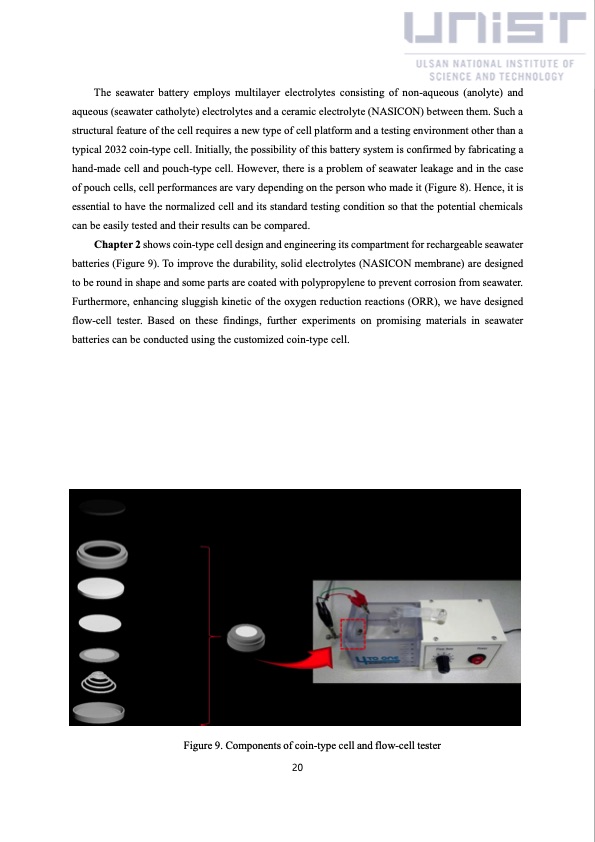
PDF Publication Title:
Text from PDF Page: 025
The seawater battery employs multilayer electrolytes consisting of non-aqueous (anolyte) and aqueous (seawater catholyte) electrolytes and a ceramic electrolyte (NASICON) between them. Such a structural feature of the cell requires a new type of cell platform and a testing environment other than a typical 2032 coin-type cell. Initially, the possibility of this battery system is confirmed by fabricating a hand-made cell and pouch-type cell. However, there is a problem of seawater leakage and in the case of pouch cells, cell performances are vary depending on the person who made it (Figure 8). Hence, it is essential to have the normalized cell and its standard testing condition so that the potential chemicals can be easily tested and their results can be compared. Chapter 2 shows coin-type cell design and engineering its compartment for rechargeable seawater batteries (Figure 9). To improve the durability, solid electrolytes (NASICON membrane) are designed to be round in shape and some parts are coated with polypropylene to prevent corrosion from seawater. Furthermore, enhancing sluggish kinetic of the oxygen reduction reactions (ORR), we have designed flow-cell tester. Based on these findings, further experiments on promising materials in seawater batteries can be conducted using the customized coin-type cell. Figure 9. Components of coin-type cell and flow-cell tester 20PDF Image | China solar seawater battery

PDF Search Title:
China solar seawater batteryOriginal File Name Searched:
solar-seawater.pdfDIY PDF Search: Google It | Yahoo | Bing
Product and Development Focus for Salgenx
Redox Flow Battery Technology: With the advent of the new USA tax credits for producing and selling batteries ($35/kW) we are focussing on a simple flow battery using shipping containers as the modular electrolyte storage units with tax credits up to $140,000 per system. Our main focus is on the salt battery. This battery can be used for both thermal and electrical storage applications. We call it the Cogeneration Battery or Cogen Battery. One project is converting salt (brine) based water conditioners to simultaneously produce power. In addition, there are many opportunities to extract Lithium from brine (salt lakes, groundwater, and producer water).Salt water or brine are huge sources for lithium. Most of the worlds lithium is acquired from a brine source. It's even in seawater in a low concentration. Brine is also a byproduct of huge powerplants, which can now use that as an electrolyte and a huge flow battery (which allows storage at the source).We welcome any business and equipment inquiries, as well as licensing our flow battery manufacturing.| CONTACT TEL: 608-238-6001 Email: greg@salgenx.com | RSS | AMP |